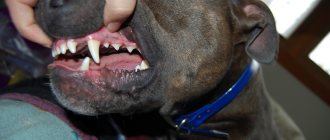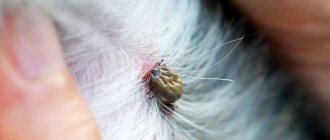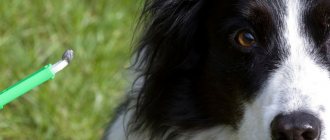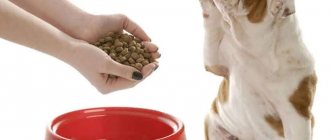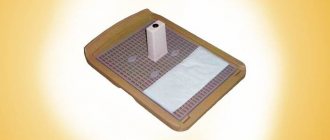Fleas in dogs are ectoparasites that most often affect domestic animals. No pet is immune from this parasitic disease, so every dog owner should know the main symptoms of the pathology, how to remove fleas from a dog and preventive measures. Flea bites cause pain to pets, the saliva of ectoparasites causes allergies, causes dermatitis, ulcers, abscesses and is a breeding ground for many serious infectious diseases. Another danger is that these small blood-sucking insects carry helminth eggs.
How can a dog get fleas?
Fleas live anywhere. They live on the street, in houses, apartments, shops, warehouses, and other utility rooms where there may be animals. Moreover, these may not be domestic animals, but rats, which are found everywhere. Rat fleas can also attack dogs.
Most often, a dog picks up fleas while walking on the playground, on the streets, in forests and parks. Infection occurs through contact with other dogs. But also a flea that has fallen from one dog can wait for another victim on the ground, bench, bushes or grass. The contact may not be too close: a flea will easily jump from one dog to another if the distance between them is about half a meter, that is, even when passing nearby.
Owners can also bring fleas home on shoes and outerwear. This is how dogs that do not walk outside and never leave the house become infected with fleas.
Fleas also enter the apartment on their own: through open windows and doors. They penetrate from common areas: basements, attics, corridors, stairs. Many old houses are infested with fleas.
Signs of a dog being infected with fleas
It is quite simple to understand that a dog has fleas. The following signs indicate this:
- the dog is constantly itching;
- anxiety, aggression;
- sleep disturbances when the animal suddenly wakes up to scratch itself;
- the appearance of wounds, ulcers, irritations on the skin;
- hair loss, excessive shedding.
Fleas on a dog can be seen by parting the fur and carefully examining the animal. This is not easy to do in thick and dark wool. Most often, parasites can be found on the withers, behind the ears and on the stomach. There can be both adults and eggs and larvae.
Why are dog fleas dangerous?
Firstly, their bites cause severe itching. The dog is constantly itching, anxious, uncomfortable, and in a bad mood.
Secondly, fleas are carriers of pathogens of dangerous infectious diseases: typhus, encephalitis, plague, etc. They carry helminth eggs and other pathogenic microorganisms.
Flea bites also cause severe allergic reactions. After them, irritation appears on the skin and it turns red, hurts, and swells.
Many people think that fleas from dogs are not transmitted to humans. This is true: dog fleas do not live on people. But they bite people. And their bites are unpleasant, causing severe itching and allergic reactions. And if a person is bitten by an infected flea, it can infect him.
Flea remedies for dogs
Manufacturers produce a wide variety of anti-flea products and preparations. They are sold in pet stores and veterinary pharmacies. They have different uses and effectiveness.
Shampoos
Flea shampoos work when dogs don't have too many fleas. Their effect is not very long. There are flea products on sale for dogs based on natural ingredients that only repel parasites. There are also shampoos that contain insecticides that kill insects. You can use insecticides to add to your regular shampoo. For example, Ectometrin from Medilis is added to the dog’s usual bathing product in accordance with the instructions.
It is important to apply the shampoo to the entire body of the animal, but you need to protect the dog’s eyes and mucous membranes from getting it. The dog should not be allowed to lick the foam or drink the shampoo water.
There are special flea shampoos designed for bathing puppies. Each bottle should also indicate whether the product can be used on puppies or pregnant or lactating dogs. Some products are toxic and should not be used on weakened or elderly animals. It is worth consulting with your veterinarian to see if a specific product can be used to kill parasites.
After bathing with shampoo, the dog should be thoroughly rinsed with running water, the coat dried, and then combed to remove dead parasites.
Sprays
This is an effective remedy, but its application is more difficult. You should try to apply the drug not to the fur, but to the skin or as close to it as possible. When processing, you need to protect your respiratory organs and eyes; you must work strictly with gloves. Do not allow the product to get into the dog’s eyes or mucous membranes.
The dog should not be allowed to lick itself for any period of time after treatment. To do this, they put a special high neck collar on her. While the product remains active on the dog’s body, other animals who might lick the drug should not be allowed near it.
Collars
Anti-flea collars are impregnated against fleas and last for several months. After the expiration date, you need to change the collar to a new one. Sometimes collars rub the skin and can cause irritation and dermatitis. They are not recommended for use on puppies or nursing or pregnant dogs as they may be toxic.
Drops
The most effective way to combat fleas is drops on the withers. They are applied in quantities calculated by the weight of the animal. The product spreads throughout the skin and kills fleas quite quickly. The protection lasts for about a month, then the drops are applied again. Also, drops on the withers are used as a preventive measure, even if the animal is not found to have fleas, but it regularly walks in an area where the risk of infection is high.
Powder
The most inexpensive, but quite effective way. The powder is prepared to order at a veterinary pharmacy. It is based on butox. The powder is applied to the animal's skin, spreading the fur. Dogs sometimes become allergic to it, so you need to monitor your pet's condition. The disadvantage of this method, in addition to the inconvenience of application, is that the powder must be used within two weeks.
Folk remedies
All flea medications containing insecticides are toxic. Many owners are afraid to use them, thinking that the pet will be harmed. Because of this, they resort to traditional methods of getting rid of fleas.
What tools can be used:
- bathing in a decoction of wormwood, celandine, tansy;
- bath with tar or laundry soap;
- applying a gruel of crushed garlic or onion to the entire coat or just to the withers;
- adding essential oils of lavender, eucalyptus, mint, and lemongrass to bathing shampoo.
You can also drop a few drops of essential oils onto the litter and place a sprig of dry wormwood. The floors in the room where a flea-infested dog lives should be washed with a solution of salt and soda in equal proportions.
All of the above products, of course, are not as dangerous and toxic as industrially produced insecticides, but they are also ineffective. They are more likely to repel fleas, but not kill them. To get rid of insects, you will have to use such products many times. In addition, they do not destroy eggs. Another problem is that the dog may not like strong-smelling products. She may experience discomfort from them, and her sense of smell may deteriorate.
Room treatment
Considering the fact that most fleas do not live on the dog, but in the environment, they cannot be completely eliminated if you ignore the need to treat them at home.
Treating your apartment for dog fleas
First of all, you should prepare:
- Carry out a thorough cleaning.
- Remove food and seal it tightly.
- If you have aquarium fish, you will have to turn off the compressor for a while and cover the tank.
- It is better to remove reptiles and small decorative rodents from the premises.
- Wash fabric covers, curtains, etc. Be sure to disinfect your slippers.
- Knock out mattresses, blankets and pillows. If necessary, have carpets dry cleaned. But it is enough to vacuum, just like upholstered furniture.
- Prepare insecticide.
You can purchase an aerosol to treat the animal, and use it to treat the pet’s habitat after washing the bed.
In addition, there are three categories of insecticides for indoor treatment: sprays, powders, and liquid concentrates. When choosing, you should pay attention to the composition; it should contain pyrethrins, pyrethroids, imidacloprid.
The “Clean House” dust is considered one of the effective methods of baiting, but in relation to fleas - only with an integrated approach. Powders such as “Delicia”, “Pyrethrum”, “Phenaxin” are also successfully used.
Any aerosol insect repellent is suitable. The most effective: “Raptor”, “Raid”, “Dichlorvos”, “Dr. Klaus from ants and other insects."
Advice: when you don’t want to deal with bullying yourself, you should call exterminators who will solve the problem efficiently and quickly.
Dog house treatment
Disinfection should be carried out regularly to maintain the well-being of your furry friend and his health. An enclosure or kennel is the place where your pet most often visits. Ignoring sanitary standards can lead to infection or worsening the condition of a sick animal.
First of all, you need to clean the sleeping areas and the area nearby. Then disinfection is carried out. This is usually done using a solution of formalin, Lysol or creolin. The latter is the most affordable, effective and easy to dilute (30-50 ml per 10 liters of water, the emulsion is heated to 60°C before processing). The method of use of each drug is indicated in the instructions for it.
The bed is washed in hot water, the kennel is sprayed, and then the sleeping area is sprayed, for prevention.
You can also use natural remedies to treat flea boxes. Use a mixture of liquid soap with essential oils of cedar, eucalyptus, lavender, mint, juniper, and tea tree. To do this, add 1 tsp to 100 ml of soap base or dog flea shampoo. 2-4 types of oil from those listed. This composition will help drive away fleas, destroy bacteria and unpleasant odors.
Tip: after treating the booth, place wormwood sprigs on the floor, and temporarily sprinkle pine sawdust on your pet instead of bedding. These will be additional measures to combat the parasite.
Safety rules for processing
To protect your health and that of others, when working with chemicals you need to follow simple rules:
- Perform all manipulations with the active substance wearing a respirator and rubber gloves.
- Treatment of premises ensures high-quality ventilation.
- Children should not be allowed to come into contact with the purified environment for several days.
- Use only freshly prepared solutions and check the expiration date of the drug before use.
It should be remembered that even with a low level of toxicity, any disinfectant substance is poisonous.
How to get rid of fleas on a puppy
Most professional insecticides are not recommended for use on puppies. The fact is that their immune system does not work the same as that of adult animals. It has not yet fully formed, so any outside interference can seriously damage it. Conventional treatment with products that are not specifically intended for puppies can be harmful to health and affect development.
You should also avoid using home remedies, especially those with strong odors, because they can negatively affect your dog’s sense of smell.
To remove fleas from puppies, you need to take only specialized medications from a veterinary pharmacy. The bottle must indicate at what age the product can be used. If you have any doubts about whether a particular drug can be used, it is best to consult your veterinarian.
Antiparasitic collar or drops?
In addition, many breeders prefer to use an anti-parasitic collar. But it is difficult to consider it a full-fledged replacement due to the specific qualities of such protection:
- Collars are often made from the cheapest and roughest materials. This leads to the fact that they cannot be properly fixed on the dog’s neck.
- Dogs are very “gnawing” creatures, and therefore there is a high chance that the dog, having thrown off the “harness” from its neck, will first slobber all over it thoroughly. Nothing good will come of this, since insecticides taken orally are a strong and very unpleasant toxin.
- Finally, if the dog is large, then there will be no fleas on the neck, but they will feel great on the rump. The effect of the collar, unfortunately, does not extend that far.
But there are also positive nuances. Firstly, collars can in most cases be used to protect pregnant and lactating bitches. Secondly, they are also used to protect puppies.
Preventing fleas in dogs and puppies
It is impossible to completely protect your dog from fleas. She can pick them up anywhere at any time. But to prevent the infection from becoming too painful, it is important to always carefully monitor your pet’s behavior and carefully examine it. If at least one parasite is detected, you must immediately carry out flea treatment for your pet and your home.
What you need to do:
- treat the dog with drops on the withers, shampoo, powder;
- Be sure to wear a flea collar when walking;
- wash, treat with a steam cleaner, shake out, treat the litter with insecticides. a bed, a house where a dog sleeps;
- carry out general cleaning in the apartment: vacuum, beat, steam or dry-clean carpets, bedspreads, pillows, other textiles, wash floors and all smooth surfaces with insecticides;
- For prevention, after killing fleas, you can periodically wash the floors with water with the addition of essential oils.
To treat premises, you can use insectoacaricidal products produced by Medilis Laboratories: Ziper, Malathion, Neo, Super. They are diluted to the desired concentration and applied by spraying or wiping. One treatment can destroy fleas in the house and prevent their appearance within a month and a half. It is important to use them strictly according to the instructions and take normal safety precautions.
To reduce the likelihood of flea infestation, you should not let your dog interact with stray or unfamiliar animals while walking. It is better to avoid being in places where there are fleas. It is important to keep the dog’s bed or other area clean, clean it regularly, and inspect it for the presence of parasites. Attention to your pet and timely treatment will prevent dangerous diseases and keep the dog’s health and psyche in order.
Preventive actions
How to protect your home, pet and yourself from bloodsuckers? To reduce the risk of infection with blood-sucking parasites, dog owners should:
- keep your home clean;
- Regularly clean, disinfect and replace your dog’s bed;
- wash the booth and enclosure;
- floors, upholstered furniture, floor coverings must be vacuumed at least 2-3 times a week;
- examine dogs after a walk, mating, visiting a veterinarian, or participating in an exhibition;
- try to protect your pet from contact with other animals during a walk;
- walk dogs in strictly designated areas;
- use flea collars;
- At least twice a year, carry out preventive treatment of the dog with flea drops.
